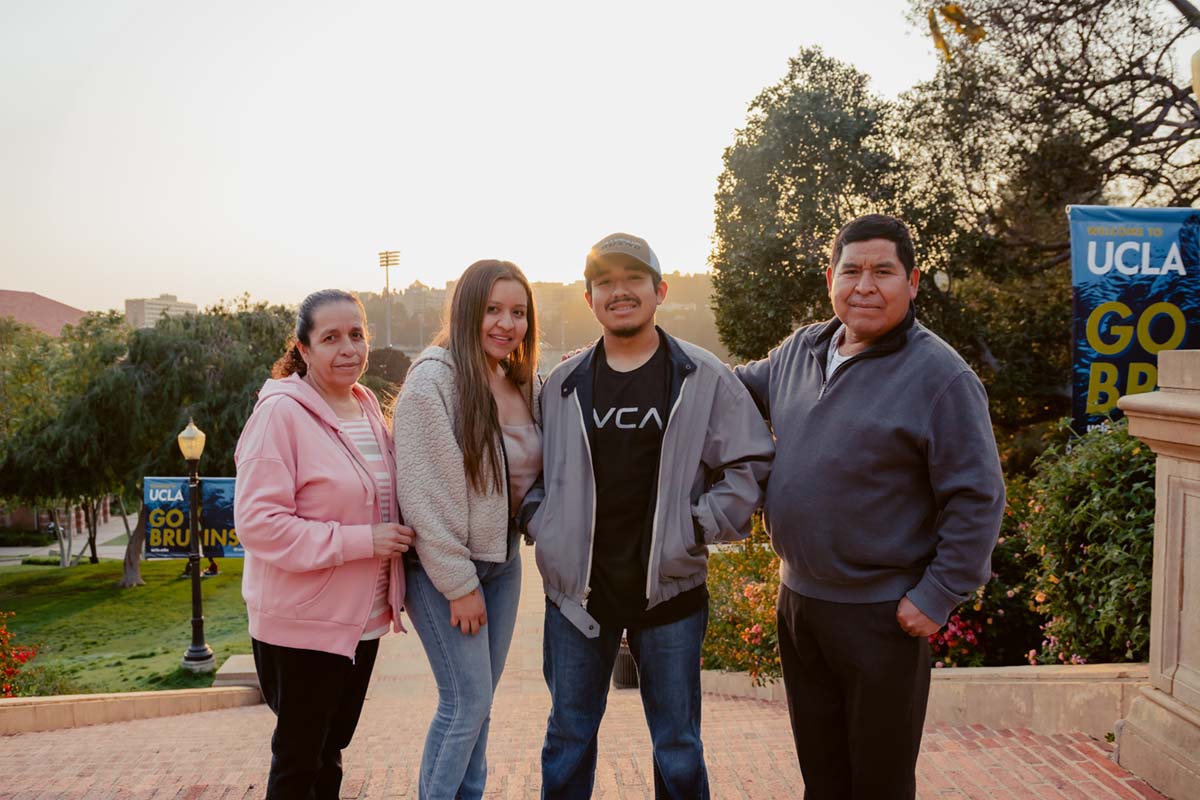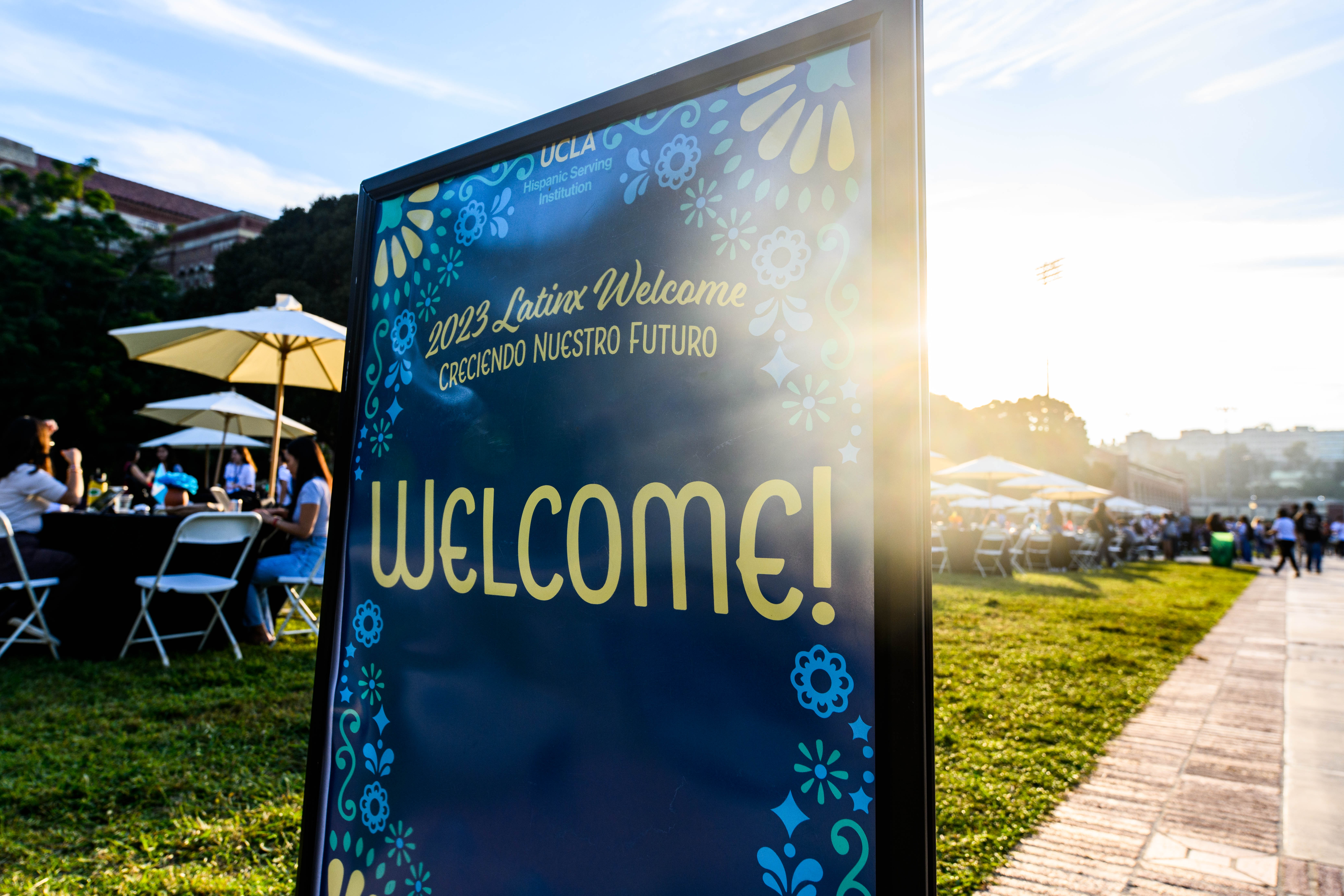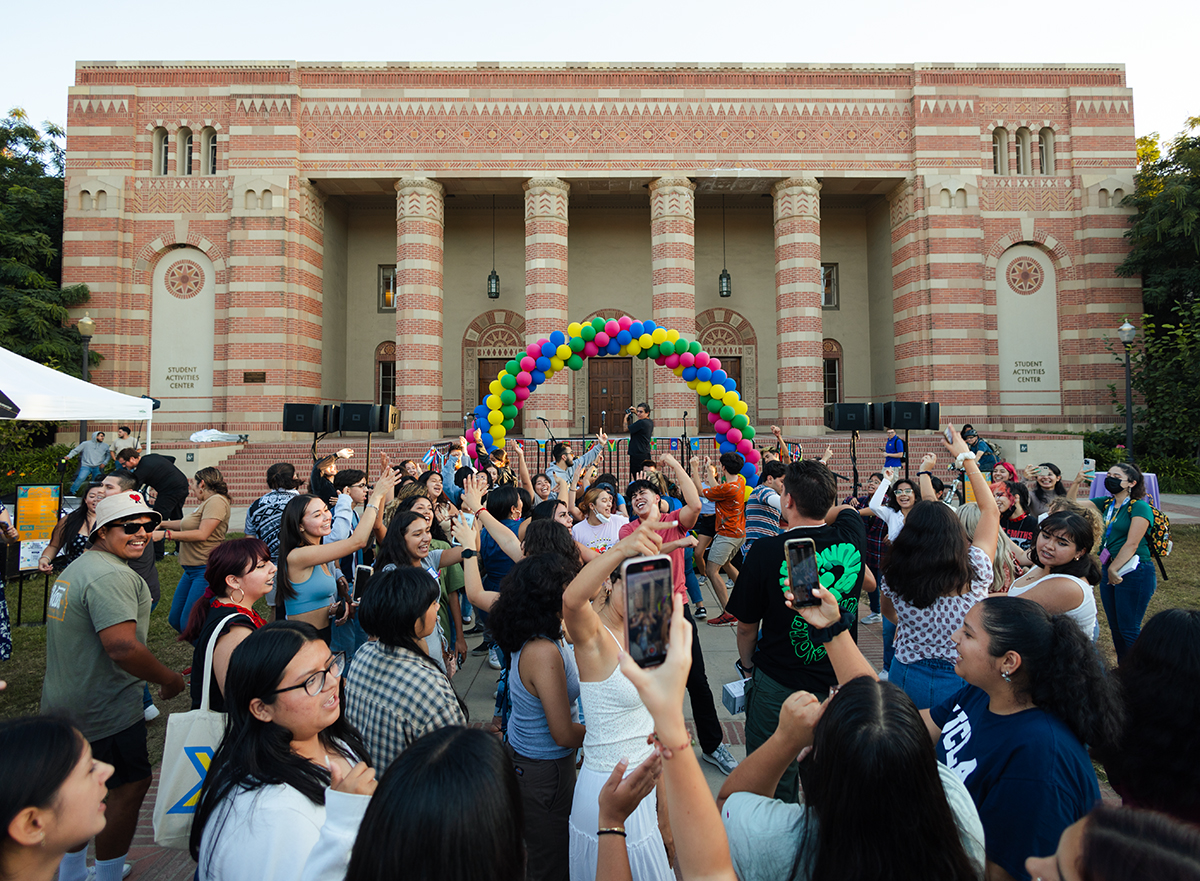(Brandon Morquecho/Assistant Photo editor)
By Brandon Morquecho
December 1, 2023 at 12:29 p.m.
Organizations like Mariachi de Uclatlán, Movimiento Estudiantil Chicana/o/x de Aztlán de UCLA, and Grupo Folkórico de UCLA brought the Latinx community on campus together to celebrate Día de los Muertos.
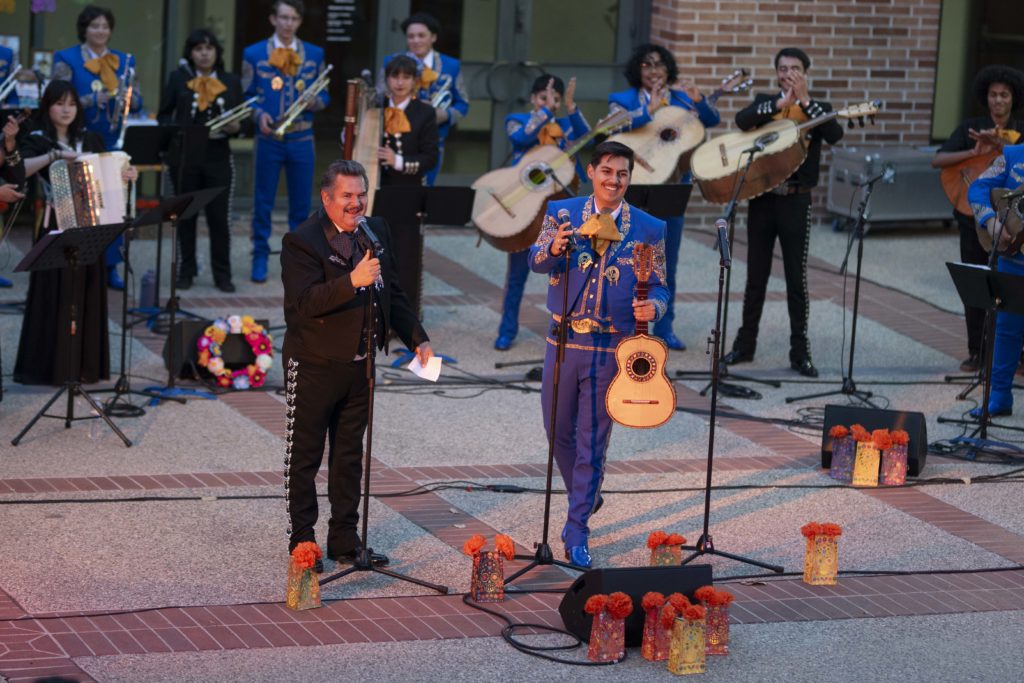
Mariachi de Uclatlán’s faculty director Jesús “Chuy” Guzmán and fourth-year ethnomusicology student Carlos Oliva announce the beginning of Uclatlán’s Día de los Muertos performance.
The performance was part of the “Fowler Out Loud” series, which involved evening concerts that took place at the Fowler Amphitheater and hosted students from across different disciplines to showcase their talents.
Guzmán, a Grammy Award-winning musical director, said, “Es una tradición donde celebramos la vida y la muerte de nuestros ancestros, de nuestra familia, de nuestros antepasados, entonces ese día lo celebramos con toda nuestra familia y amigos. ”
[It’s a tradition where we celebrate the life and the death of our ancestors, of our family, of our forefathers, and so that day we celebrate it with all our family and friends.]
He continued by listing off Mexican composers such as José Alfredo Jiménez, Manuel Esperón and Juan Gabriel, and he said the concert was a way to pay respect to the people who gave their life for the art.
“Tantos compositores que hicieron tanto por nuestra música, entonces nosotros le damos homenaje a ellos con sus canciones para que el público que ve nuestros conciertos se de cuenta que hay más que una canción que se está escuchando en el radio de otro tipo de música.”
[So many composers that did so much for our music and so we bring tribute to their songs so that the public that sees our concerts knows that there is more to a song what is playing on the radio in another style of music.]
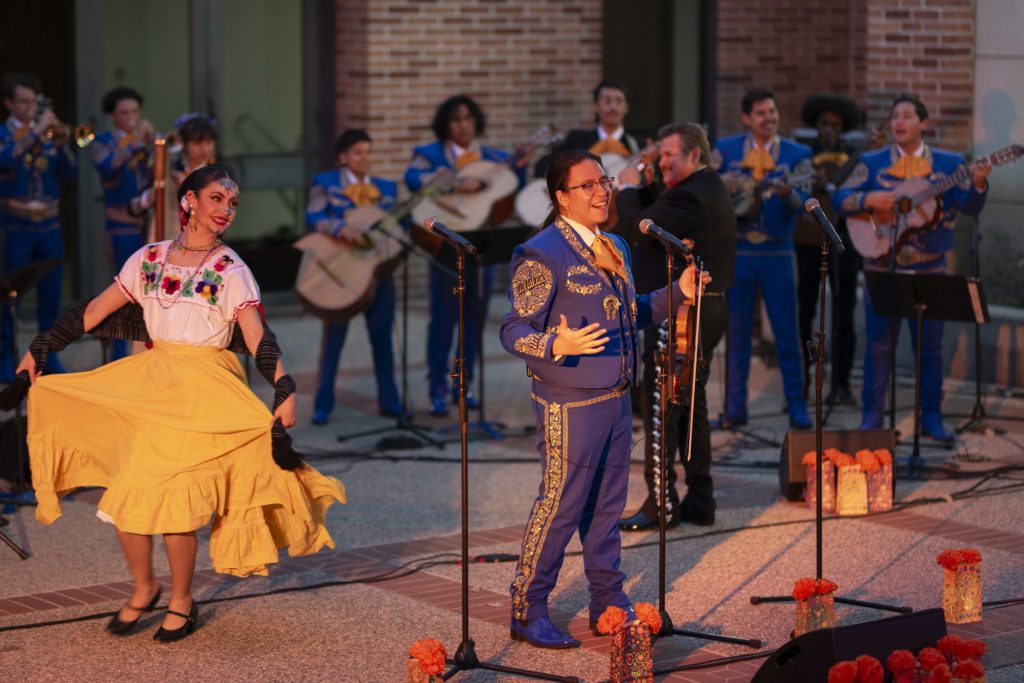
Third-year ethnomusicology student Bobby Alvarez sings as third-year biology student Alondra Banda dances around him.
“El baile y la música, yo creo que van de la mano, si, osea van juntos,” Guzmán explained. “Donde hay música debe de haber baile y pues hacemos alianza con la danza para darle otro color a lo que es la festividad. Si, que el público disfrute no tan solo de la música sino también que vea, osea, la hermosura que hay también dentro de la danza.”
[The dance and the music I think go hand in hand, yes, I mean they go together. Where there is music there has to be dance, and well, we do an alliance with the dance to give the festivity another color. Yes, the public not only enjoys the music but they also see the beauty that there is within the dance.]
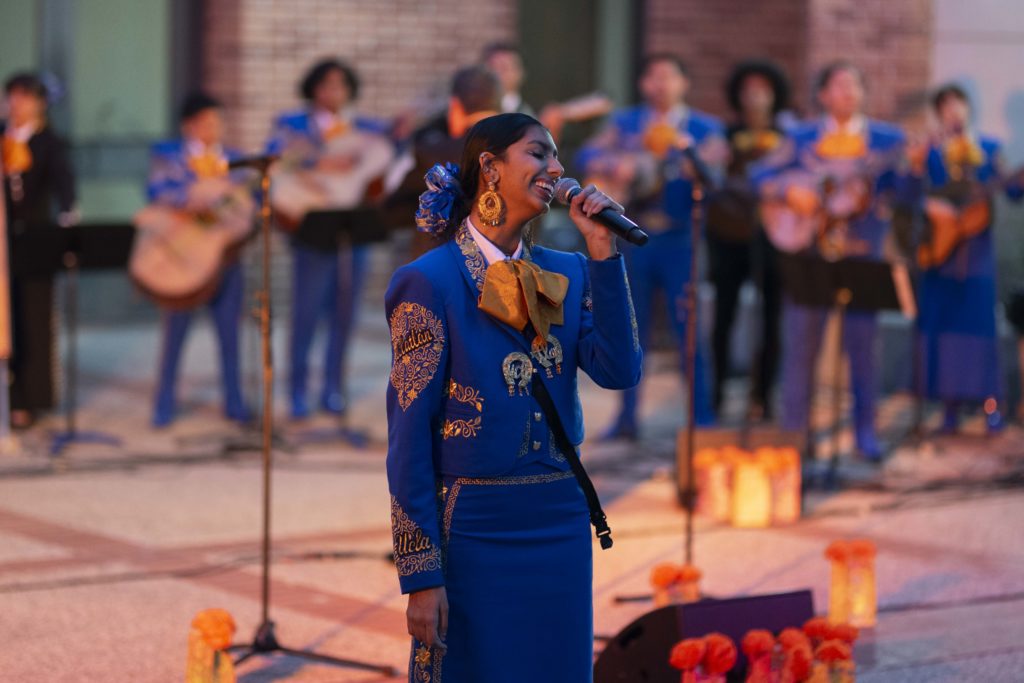
UCLA alumni Saveena Patel enchants the audience with her rendition of “Cien Años” by Pedro Infante.
Guzmán said he believes that mariachi music has the power to evoke emotions in people, regardless of their background.
“Tiene [la música mexicana] un sentimiento como los demás estilos de música, entonces el público siente la energía tanto como cuando está alegre el tema, también como cuando se pone medio triste. Osea, el público va absorbiendo todo eso porque, pues, la música es vida.”
[It [Mexican music] has a sentiment like other styles of music, so the public feels the energy when it is a happy theme, as well as when it becomes sort of sad. I mean, the public is absorbing everything because, well, music is life.]
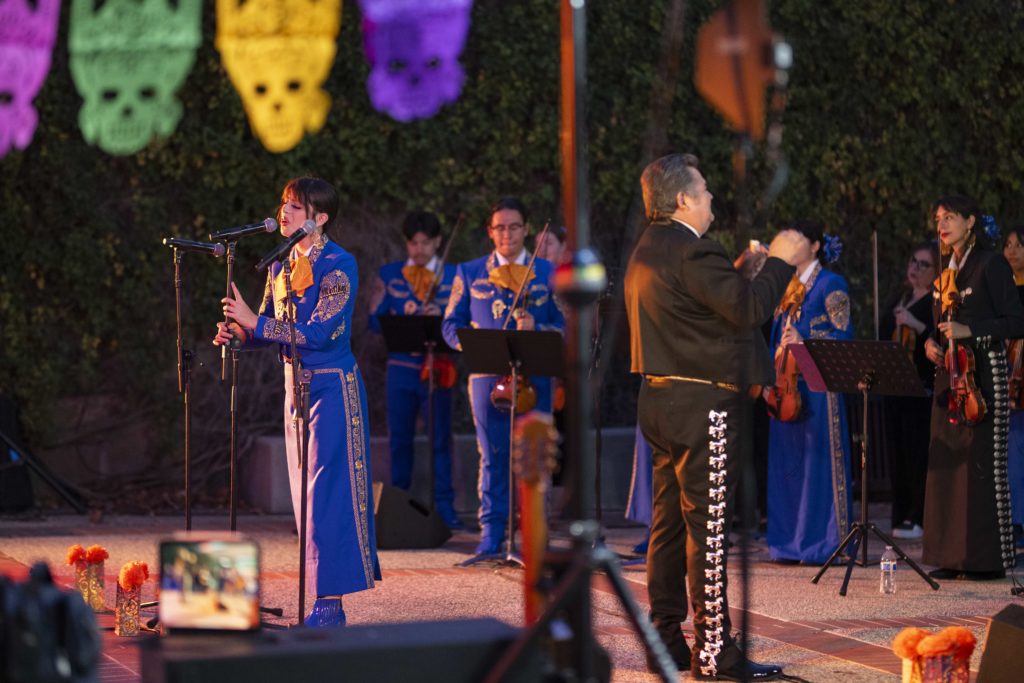
First-year global jazz studies student Paulina Perez sings as the rest of the mariachi plays behind her.
Perez serenaded the crowd with a rendition of “El Pastor” by Miguel Aceves Mejia, a song that was first released in 1955 and describes the beauty found in the rural parts of Mexico.
Guzmán elaborated on the importance of the huapango, a Mexican genre of music that comes from the ‘Huasteca’ regions of Mexico. “Es uno de los huapangos más conocidos que hay en el nivel ranchero. Es un huapango hermoso. Paulina tiene una voz muy bonita y se lució haciendo su canción.”
[It is one of the most recognized huapangos, in terms of Ranchera music. It is a beautiful huapango. Paulina has a very beautiful voice and she showed it off with the song.]
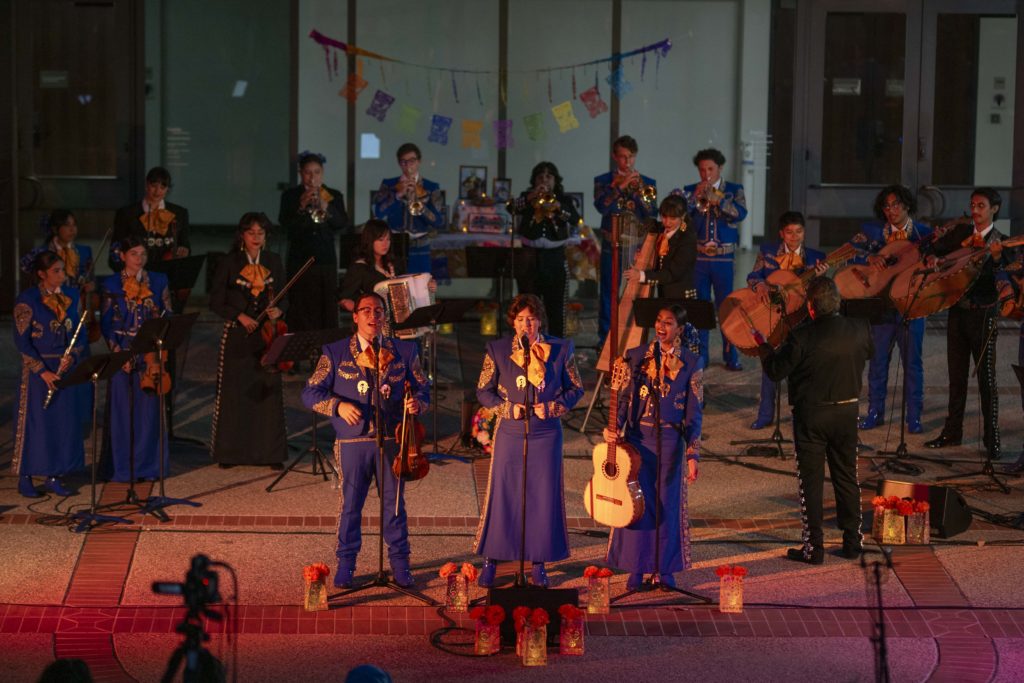
Third-year ethnomusicology and neuroscience student Sylvia Rutkowsky, Alvarez and Patel combine their voices in a harmony.
Though Uclatlán performed songs such as “José Alfredo Jiménez Popurri,” “La Llorona” and “Homenaje a Linda Ronstadt, ” the band’s director opted to begin the mariachi’s performance with “Fiesta en Jalisco” by Mariachi Vargas de Tecalitlán.
“¿Porqué ‘Fiesta de Jalisco’? Porque el día de los muertos es fiesta,” Guzmán explained. “Si lo vemos del lado positivo, es una celebración y una celebración es una fiesta. Entonces, pues, son canciones rancheras que son alegres, del estado de Jalisco.”
[Why ‘Fiesta de Jalisco’? Because the Day of the Dead is a festivity. If we see it as a positive thing, it’s a celebration, and a celebration is a party. So they are ranchera songs that are happy, from the state of Jalisco.]
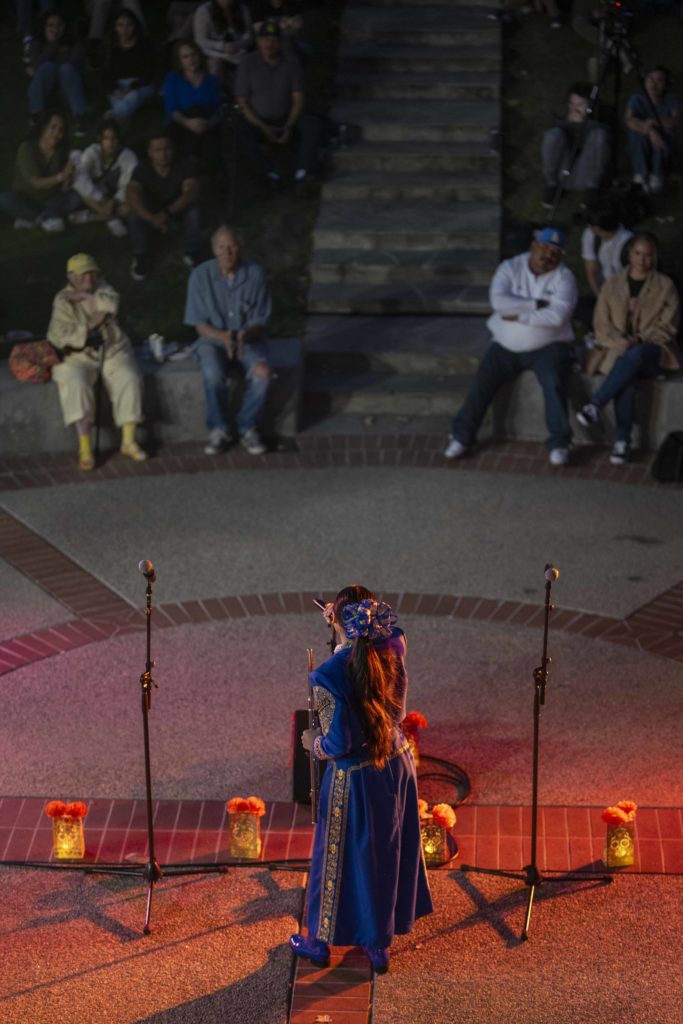
The crowd listens intently as a vocalist from Uclatlán takes center stage.
Guzmán spoke about the longevity of mariachi music.
He said, “La radio siempre se va enfocando en cosas nuevas y aun así, el mariachi tiene una existencia de más de 200 años y sigue quedando. Y ósea, mientras nosotros no doblemos las manos y no dejemos que esto muera, la música de mariachi va seguir siendo viva.”
[The radio is always focusing on new things and even then, the mariachi has an existence of over 200 years and it still remains. And I mean, as long as we don’t fold our hands (concede) and we don’t let that die, then mariachi music will continue to live.]
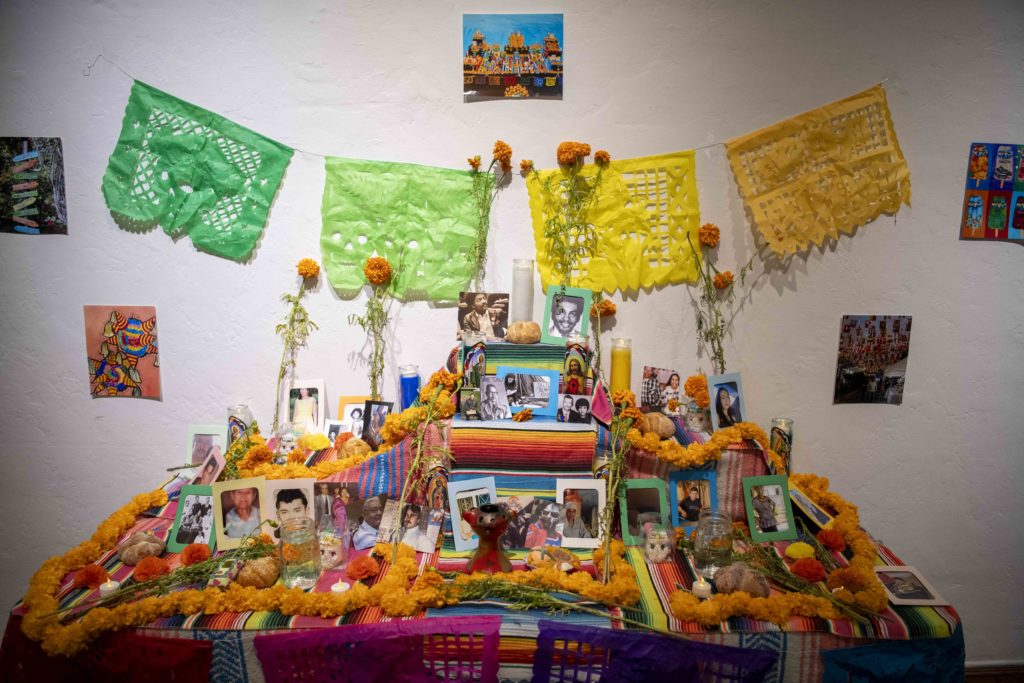
An altar, decorated with cempasúchil flowers, also known as marigolds, photos of loved ones and papel picado is displayed as a part of the CAC’s Kerckhoff Art Gallery.
The altars, also known as ofrendas, are ways to welcome the souls of the dead into the living world. They feature key items such as the cempasúchil flowers, which are believed to help lead the souls back to the homes of their families. These ofrendas can be personalized by including the deceased’s favorite foods, drinks and sweets.
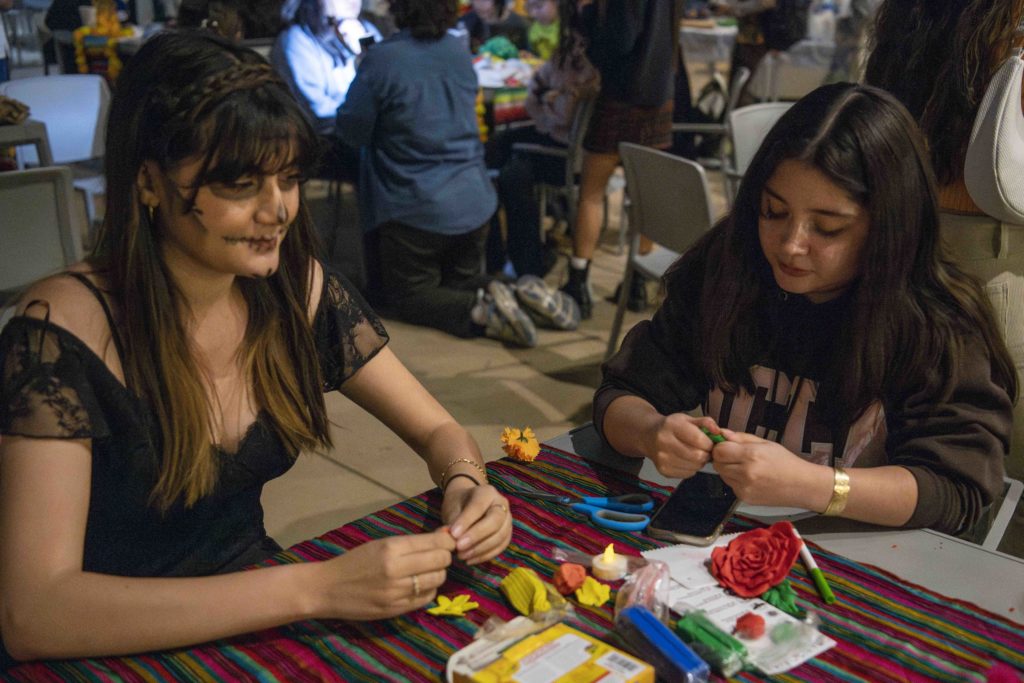
Fourth-year Chicana and Chicano studies student Nancy Gomez (left) and first-year biochemistry student Yazmin Ramos (right) mold playdough into flowers during an event hosted by Movimiento Estudiantil Chicana/o/x de Aztlán de UCLA.
Ramos said events like the one hosted by MEChA helps her stay connected to her roots.
“I love it here, because there’s always going to be activities for your culture, you know. It feels nice because you actually feel like home.”
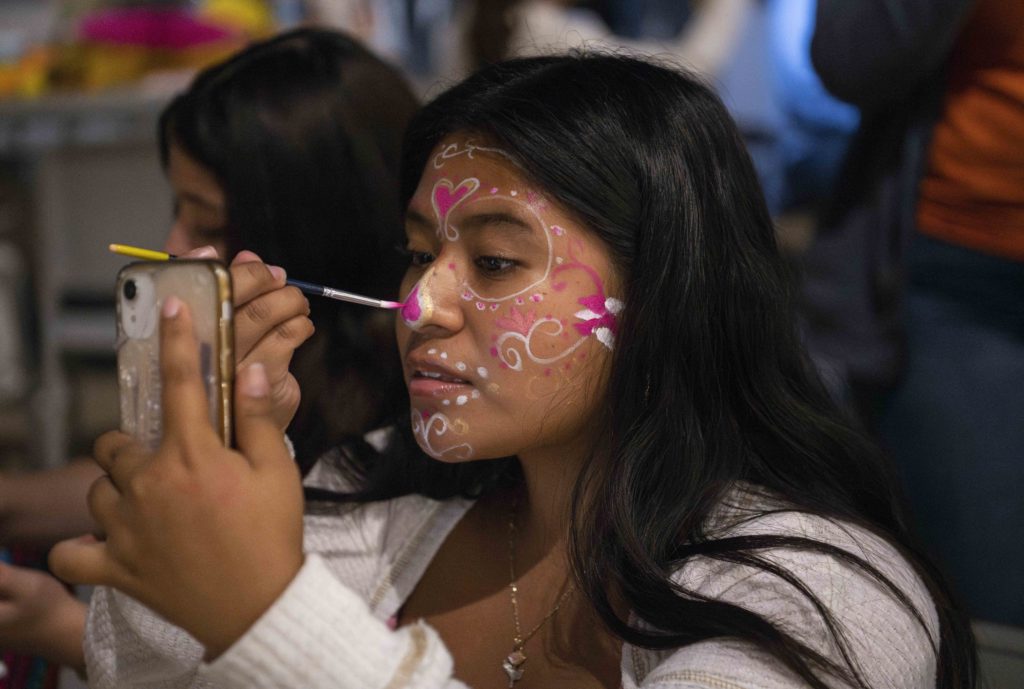
First-year public affairs student Mayra Bahena uses her cellphone as a mirror as she paints her face.
“I would say it (events on campus) does help me stay connected with my culture, mainly because here, I think it’s very different. Back home, I was surrounded by my Latino community,” Bahena explained. “Here, I think you really have to look for it, you have to go out of your way to really look for organizations that cater to you and you feel included in them.”
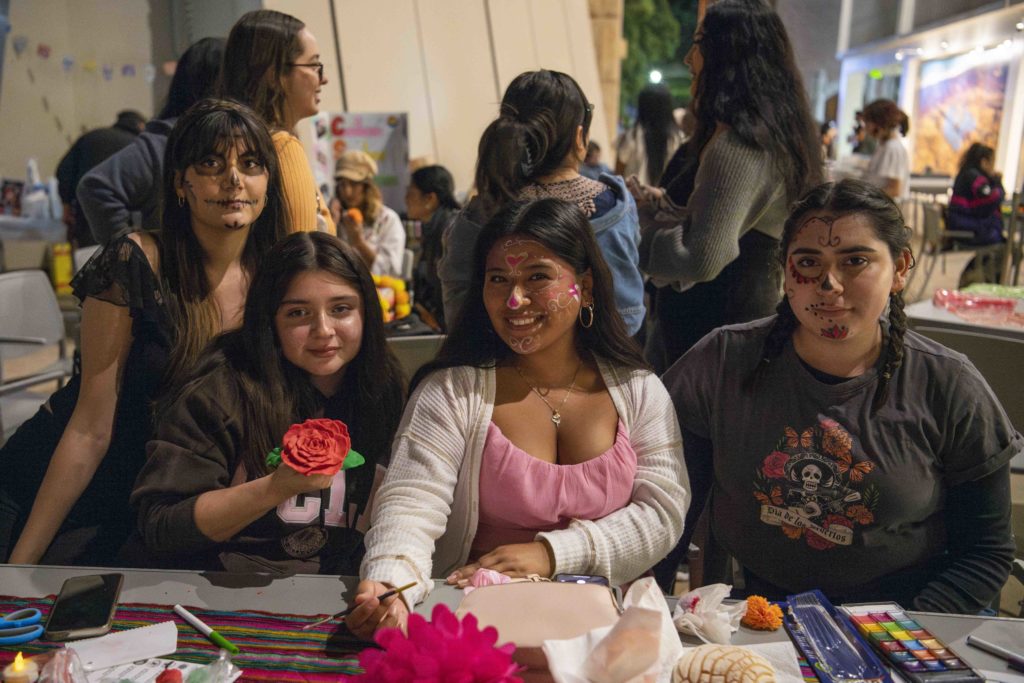
First-year political science student Mayah Guizar, alongside Bahena, Gomez and Ramos, pose for a photo.
“I always celebrate Day of the Dead to honor my grandparents. So I always do a huge altar and, coming here, I was scared I was gonna lose it,” Guizar said, “But it was really nice to see that they were also having Day of the Dead stuff because I saw, not just this one, but like several different events on campus. So it was nice to feel connected, even far away from home.”
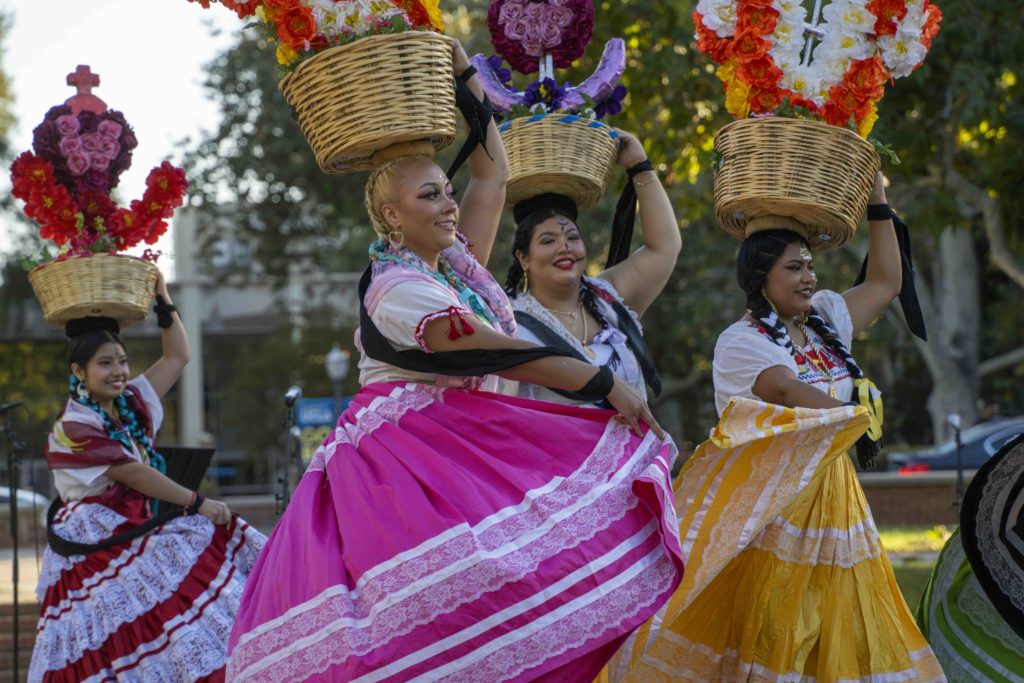
Dancers wearing colorful dresses and a flower basket on top of their heads, representing the region of Oaxaca Valles Centrales, smile as they dance.
The performers danced to the song “Chinas Oaxaqueñas” and “Jarabe del Valle.”
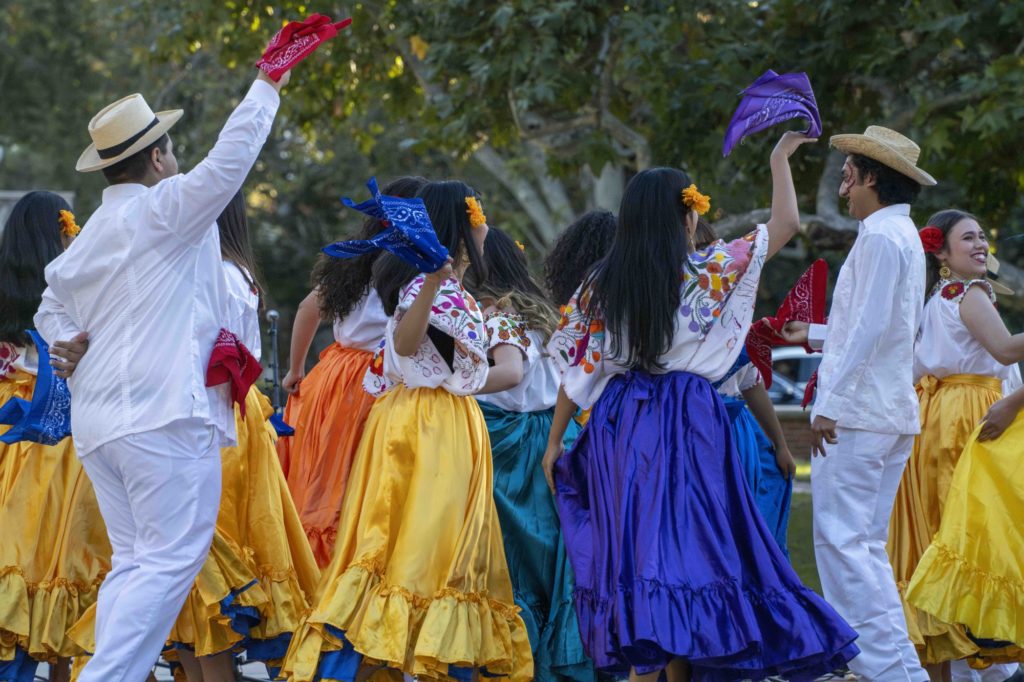
Performers of Grupo Folklórico dance in the Sunken Gardens at UCLA.
The dancers represented the Mexican region of Costa Chica de Guerrero y Oaxaca. For the duration of their performance, some of the dancers used handkerchiefs as they danced in pairs.

Rutkowski pauses from playing the trumpet and belts out a lyric.
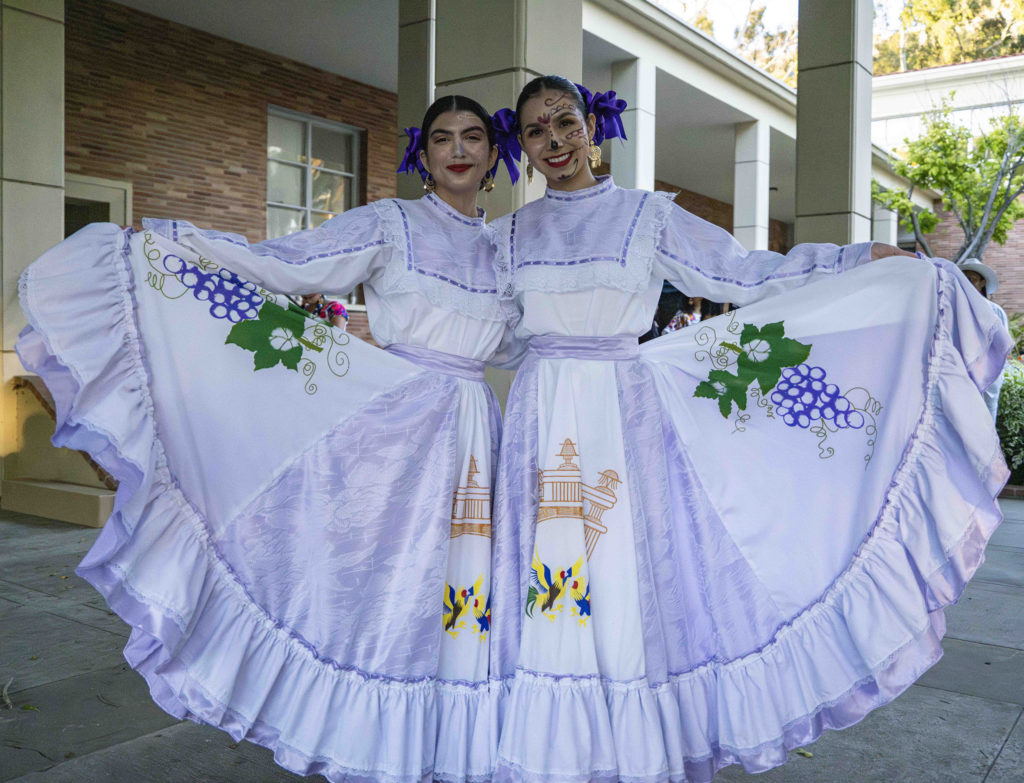
Second year psychobiology student Kylie Barragan (right) and second year political science student Sophia Madera (left) pose for a photo dressed in a purple and white dress with a grape pattern.
“Yeah, I think it’s definitely really important to showcase our heritage and culture itself. It’s really meaningful because I get to connect not only with my Latinx community here, but I can also communicate and stay connected with my family and my culture as well. So, it’s really beautiful to showcase and put on a performance like this for everyone, where they’re able to see and learn a bit about our culture, and we get to display and appreciate our culture as well,” said Sophia Madera.
The duo danced to the beat of “Pelea de Gallos” by Mariachi Vargas de Tecalitlán to represent the Mexican region of Aguascalientes.


